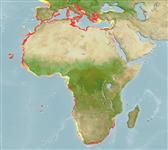>
Eupercaria/misc (Various families in series Eupercaria) >
Sparidae (Porgies)
Etymology: Lithognathus: Greek, lithos = stone + Greek, gnathos = jaw (Ref. 45335).
More on author: Linnaeus.
Environment: milieu / climate zone / intervalo de profundidade / distribution range
Ecologia
marinhas; estuarina demersal; intervalo de profundidade 0 - 150 m (Ref. 3688), usually 10 - 20 m (Ref. 37413). Subtropical; 48°N - 35°S, 25°W - 36°E
Eastern Atlantic: Bay of Biscay, Strait of Gibraltar, Mediterranean, and Black Sea (Ref. 4781, 112870), Madeira Is (Ref. 74541), Canary Is. and Cape Verde Islands (Ref. 3688), southward to Cape of Good Hope, South Africa. Western Indian Ocean: southern Mozambique (Ref. 3688); Red Sea (Ref. 84159). Not found in tropical east Africa (Ref. 3198),
Length at first maturity / Tamanho / Peso / Idade
Maturidade: Lm 17.4, range 20 - ? cm
Max length : 55.0 cm TL macho/indeterminado; (Ref. 3397); common length : 30.0 cm TL macho/indeterminado; (Ref. 3688); Idade máx. registada: 12 anos (Ref. 13716)
Descrição breve
Chaves de identificação | Morfologia | Morfometria
Espinhos dorsais (total) : 11; Raios dorsais moles (total) : 12 - 13; Espinhos anais: 3; Raios anais moles: 10 - 11.
Body shape (shape guide): fusiform / normal.
Found on the shelf, over sandy and muddy bottoms as well as seagrass-beds and estuaries. Gregarious, sometimes forming sizeable schools. Feeds on worms, mollusks and small crustaceans. Protandric hermaphrodite (Ref. 3688). Flesh excellent (Ref. 3198); sold fresh and dried.
A monandric species (Ref. 55367). In the northern Adriatic, overall male to female ratio was 1:1.62. Sex inversion occurred mainly between 24.1 and 35.2 cm TL and 3.5 years of age (Ref. 55367). Conflicting descriptions of the reproductive style of this species have been reported, including possible gonochorism (Ref. 103751). Also Ref. 28504.
Bauchot, M.-L. and J.-C. Hureau, 1990. Sparidae. p. 790-812. In J.C. Quero, J.C. Hureau, C. Karrer, A. Post and L. Saldanha (eds.) Check-list of the fishes of the eastern tropical Atlantic (CLOFETA). JNICT, Lisbon; SEI, Paris; and UNESCO, Paris. Vol. 2. (Ref. 3688)
Categoria na Lista Vermelha da IUCN (Ref. 130435: Version 2025-1)
Ameaça para o homem
Harmless
Utilização humana
Pescarias: pouco comercial; peixe desportivo: sim
Ferramentas
Relatórios especiais
Descarregue XML
Fontes da internet
Estimates based on models
Preferred temperature (Ref.
123201): 17.1 - 27.5, mean 24.4 °C (based on 224 cells).
Phylogenetic diversity index (Ref.
82804): PD
50 = 0.5625 [Uniqueness, from 0.5 = low to 2.0 = high].
Bayesian length-weight: a=0.01202 (0.01075 - 0.01344), b=3.02 (2.99 - 3.05), in cm total length, based on LWR estimates for this species (Ref.
93245).
Nível Trófico (Ref.
69278): 3.5 ±0.39 se; based on food items.
Generation time: 4.8 (4.0 - 5.6) years. Estimated as median ln(3)/K based on 12
growth studies.
Resiliência (Ref.
120179): Médio, tempo mínimo de duplicação da população 1,4 - 4,4 anos (K=0.24; tm=2).
Prior r = 0.54, 95% CL = 0.36 - 0.81, Based on 1 full stock assessment.
Fishing Vulnerability (Ref.
59153): Moderate vulnerability (40 of 100).
🛈
Climate Vulnerability (Ref.
125649): Low to moderate vulnerability (31 of 100).
🛈
Nutrients (Ref.
124155): Calcium = 72.3 [42.6, 133.6] mg/100g; Iron = 1.06 [0.62, 1.89] mg/100g; Protein = 19 [18, 21] %; Omega3 = 0.417 [0.289, 0.641] g/100g; Selenium = 28.2 [14.1, 49.5] μg/100g; VitaminA = 9.68 [3.47, 23.67] μg/100g; Zinc = 0.831 [0.601, 1.145] mg/100g (wet weight); based on
nutrient studies.
